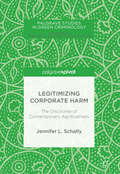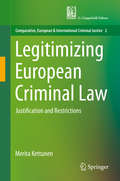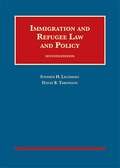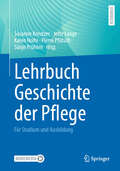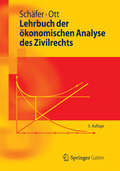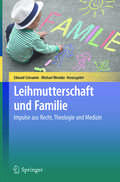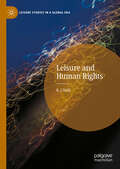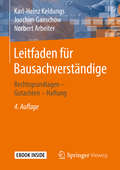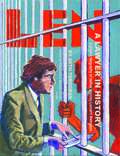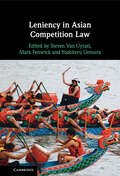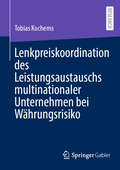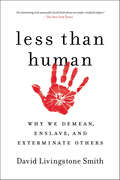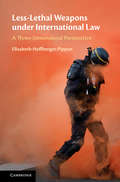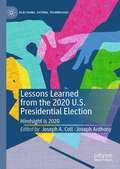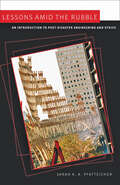- Table View
- List View
Legitimate Targets?
by Janina DillBased on an innovative theory of international law, Janina Dill's book investigates the effectiveness of international humanitarian law (IHL) in regulating the conduct of warfare. Through a comprehensive examination of the IHL defining a legitimate target of attack, Dill reveals a controversy among legal and military professionals about the 'logic' according to which belligerents ought to balance humanitarian and military imperatives: the logics of sufficiency or efficiency. Law prescribes the former, but increased recourse to international law in US air warfare has led to targeting in accordance with the logic of efficiency. The logic of sufficiency is morally less problematic, yet neither logic satisfies contemporary expectations of effective IHL or legitimate warfare. Those expectations demand that hostilities follow a logic of liability, which proves impracticable. This book proposes changes to international law, but concludes that according to widely shared normative beliefs, on the twenty-first-century battlefield there are no truly legitimate targets.
Legitimating the Law: The Struggle for Judicial Competency in Early National New Hampshire
by Susan ReidJohn Phillip Reid is one of the most highly regarded historians of law as it was practiced on the state level in the nascent United States. He is not just the recipient of numerous honors for his scholarship but the type of historian after whom such accolades are named: the John Phillip Reid Award is given annually by the American Society for Legal History to the author of the best book by a mid-career or senior scholar. Legitimating the Law is the third installment in a trilogy of books by Reid that seek to extend our knowledge about the judicial history of the early republic by recounting the development of courts, laws, and legal theory in New Hampshire. Here Reid turns his eye toward the professionalization of law and the legitimization of legal practices in the Granite State—customs and codes of professional conduct that would form the basis of judiciaries in other states and that remain the cornerstone of our legal system to this day throughout the U.S. Legitimating the Law chronicles the struggle by which lawyers and torchbearers of strong, centralized government sought to bring standards of competence to New Hampshire through the professionalization of the bench and the bar—ambitions that were fought vigorously by both Jeffersonian legislators and anti-Federalists in the private sector alike, but ultimately to no avail.
Legitimizing Corporate Harm
by Jennifer L. SchallyThis book utilizes critical discourse analysis to illuminate the ways in which one of the largest agribusinesses in operation, Tyson Foods, disguises their actions whilst simultaneously presenting the image of a benign, good corporate citizen. Schally unveils how the discourses employed by Tyson gain legitimacy by drawing on and aligning with larger cultural discourses that are often taken for granted and not adequately scrutinised. This original research, situated at the intersection of green and cultural criminologies, contributes to these current perspectives as well as to the burgeoning social harm approach within criminology. A bold and engaging study, this book will be indispensable for students and scholars of green criminology, corporate crime, animals and society, and environmental sociology, as well as environmental and animal rights activists.
Legitimizing European Criminal Law: Justification and Restrictions (Comparative, European and International Criminal Justice #2)
by Merita KettunenThe book examines how and according to which principles the enactment of European criminal legislation is legitimate. The approach adopted here focuses on the constitutionalization of criminal law (i.e., the growing importance of constitutional elements of the EU legal order and the ECHR regime within criminal law). Further, it shows how and why criminal law has a unique nature, and why it should not be equated with other fields of EU law.The book explains the basic research questions and methodologies, before turning to the nature of criminal law at the level of national law, and addressing the different levels of justification for criminal law. Further, it examines the most prominent features of European criminal law and the difference between general EU law and EU criminal law, as well as the theoretical ideals for European constitutional structures and criminal law. Examples of how the law in practice might not always be in keeping with these normative ideals serve to round out the coverage.
Legomsky and Thronson's Immigration and Refugee Law and Policy
by Stephen H. Legomsky David B. ThronsonAdopted at 185 U.S. law schools since its inception, this casebook mixes theory, policy, and politics with legal doctrine, planning, and problem-solving. The book incorporates key current issues and events, and is rich in policy analysis, fact problems, and simulation exercises. The new edition incorporates the sweeping developments of the past five years. Highlights include: Prosecutorial discretion, “zero-tolerance” and immigration-related criminal charges, and sanctuary cities Updates on DACA and DAPA Detention and Jennings v. Rodriguez The Travel Ban and Trump v. Hawaii A rewritten section on children, the family separation policy, and SIJ status Attacks on the independence of the immigration courts Revamped section on asylum, with full coverage of A-B-, other gender-related and gang-related asylum cases, non-state actors, and new credible fear guidance Major restructuring of materials on the immigration consequences of crime, including the categorical and modified categorical approaches, incorporating major court decisions Terminations of temporary protected status Dramatic cuts to the overseas refugee program Pereira v. Sessions and immigration court jurisdiction Kerry v. Din and judicial review of consular visa denials Sessions v. Morales-Santana and gender distinctions in citizenship acquisition Expanded coverage of VAWA and T & U-visas Material support for terrorism and Matter of A-C-M- Proposed new rules on public charge
Lehrbuch Geschichte der Pflege: Für Studium und Ausbildung
by Pierre Pfütsch Karen Nolte Susanne Kreutzer Jette Lange Sünje PrühlenDieses Lehrbuch richtet sich an Lehrende im Pflegestudium und in der generalistischen Ausbildung und stellt einen Zusammenhang der Pflegegeschichte zum heutigen Berufsbild dar. Das Curriculum zum neuen Pflegeberufegesetz sieht vor, die geschichtlichen Hintergründe der Pflege praxisnah im theoretischen Unterricht aufzuarbeiten. Die Autor*innen geben einen Überblick über die relevanten historischen Inhalte, stellenhistorische Quellen zur Verfügung und zeigen auf, wie diese in die Lehre integriert werden können. Worauf beruht das professionelle Berufsverständnis von heute? Gibt es einen Unterschied zwischen der konfessionellen und weltlichen Krankenpflege? Wie sah das Verhältnis von Pflege und Medizin früher aus? Wie entwickelte sich die Pflegeausbildung in Deutschland? Welche Unterschiede und Gemeinsamkeiten sind zwischen dem pflegerischen Handeln zu früheren Zeiten und heute erkennbar?
Lehrbuch der ökonomischen Analyse des Zivilrechts
by Hans-Bernd Schäfer Claus OttDie Grundlagen der ökonomischen Analyse des Zivilrechts werden in diesem Buch anschaulich erörtert. Die Autoren des einzigen deutschen Lehrbuchs zu diesem Thema berücksichtigen dabei das Delikts-, Vertrags- und Sachenrecht, das Immaterialgüterrecht sowie das Insolvenzrecht und Grundzüge des Unternehmensrechts. Ein neuer Schwerpunkt der umfassend aktualisierten 5. Auflage ist der Einfluss der verhaltensökonomischen Forschung auf diese Analyse. Zudem werden die Europäisierung des Rechts und die internationale Konkurrenz von Rechtsnormen einbezogen.
Lehrbuch der ökonomischen Analyse des Zivilrechts
by Hans-Bernd Schäfer Claus OttDieses Buch enthält die Grundlagen der ökonomischen Analyse des Rechts und ihrer Anwendung auf das deutsche Zivilrecht. Es ist eine umfassende Darstellung dieser Forschungsrichtung, in der die Normen und Regelungsprobleme mit den Mitteln der ökonomischen Theorie analysiert und bewertet werden. Wichtige Argumentationsfiguren der ökonomischen Analyse des Rechts werden in die zivilrechtliche Dogmatik eingebaut. Bei der Analyse rechtlicher Regeln des Gesetzesrechts und des Richterrechts wird gezeigt, inwieweit diesen ökonomische Kriterien zugrunde liegen und inwieweit derartige Kriterien für die Rechtsanwendung und Rechtsfortbildung fruchtbar gemacht werden können. Die 6. überarbeitete Auflage präsentiert in fast allen Kapiteln neue Ergebnisse der rechtsökonomischen Forschung. Die psychologische Verhaltensforschung hat mittlerweile Eingang in die Diskussion vieler Facetten des Zivilrechts gefunden. Einige vieldiskutierte empirische Forschungsergebnisse wie zu den Wirkungen des kontinentaleuropäischen Rechts im Verhältnis zum Common Law müssen heute - insbesondere im Gesellschaftsrecht - in neuem Licht gesehen werden. Solche Entwicklungen werden aufgegriffen und es wird untersucht, ob und inwieweit diese Forschungsergebnisse für die ökonomische Analyse des Zivilrechts von Bedeutung sind.
Leibniz: Logico-Philosophical Puzzles in the Law
by Giovanni Sartor Bernardo Pieri Alberto ArtosiThis volume presents two Leibnizian writings, the Specimen of Philosophical Questions Collected from the Law and the Dissertation on Perplexing Cases. These works, originally published in 1664 and 1666, constitute, respectively, Leibniz's thesis for the title of Master of Philosophy and his doctoral dissertation in law. Besides providing evidence of the earliest development of Leibniz's thought and amazing anticipations of his mature views, they present a genuine intellectual interest, for the freshness and originality of Leibniz's reflections on a striking variety of logico-philosophical puzzles drawn from the law. The Specimen addresses puzzling issues resulting from apparent conflicts between law and philosophy (the latter broadly understood as comprising also mathematics, as well as empirical sciences). The Dissertation addresses cases whose solution is puzzling because of the convoluted logical form of legal dispositions and contractual clauses, or because of conflicting priorities between concurring parties. In each case, Leibniz dissects the problems with the greatest ingenuity, disentangling their different aspects, and proposing solutions always reasonable and sometimes surprising. And he does not refrain from peppering his intellectual acrobatics with some humorous comments.
Leiden und Lebenskunst: Biographisch-philosophische Studien zu Krisen, Therapien und Wandlungen (Schriften zur Kritischen Lebenskunst)
by Günter Gödde Jörg Zirfas Eike BrockIndividuelle Überlegungen zur Lebenskunst bieten Orientierungen und Strategien im Umgang mit Krisenerfahrungen in prekären Zeiten. Wer Studien zu Krankheiten und Leidenserfahrungen, Therapien und Wandlungen betreibt, der verschränkt mithin die Lebenskunstmodelle mit den Biographien bedeutender Persönlichkeiten und verdeutlicht damit, wie wichtig der biographische Entstehungskontext für die Modelle ist. Den zentralen Gesichtspunkt bildet dabei die explizite oder implizite Innenperspektive auf die Lebenskunst, auf die mit ihr verbundenen Kategorien und Prozesse, Organisationsformen und Institutionalisierungen und damit auf die Wandlungen und Strukturen ihrer Theorien und Praktiken eines gelungenen Lebens, auf die Erzeugung von Sinn und Glück, den Aufbau von Identität und den Umgang mit den anderen und der Welt. Die hier präsentierte Auswahl an bedeutenden Autorinnen und Autoren der Moderne – von Michel de Montaigne bis Martha Nussbaum – belegt, dass der Ausgangspunkt für Überlegungen zur Lebenskunst in ihren körperlichen, psychischen, sozialen oder kulturellen Krisen bzw. „Krankheiten“ oder Leidenserfahrungen besteht, die wiederum spezifische Lebenskünste zur Folge haben.
Leihmutterschaft interdisziplinär: Aktuelle Perspektiven
by Asadeh Ansari-BodeweinDer vorliegende Band enthält eine Sammlung von Aufsätzen zum Thema Leihmutterschaft aus Blickrichtungen verschiedener Disziplinen, die allesamt jeweils an den aktuellen Forschungsstand anknüpfen. Das Buch wendet sich an Interessierte aller Fächer, die sich mit der kontrovers diskutierten Frage nach einer Liberalisierung von Leihmutterschaftsmodellen befassen und gibt dabei einen Einblick in die Grundlagen der Diskussion in den relevanten Fächern Philosophie, Psychologie, Soziologie, Rechtswissenschaft und Medizin.
Leihmutterschaft und Familie: Impulse aus Recht, Theologie und Medizin
by Edward Schramm Michael WermkeDas Buch betrachtet das Thema Leihmutterschaft aus einer breit angelegten, interdisziplinären Perspektive. In Deutschland ist die Leihmutterschaft verboten, in vielen anderen Ländern legal. Viele Menschen erfüllen sich den Wunsch nach einem Kind daher im Wege einer Leihmutterschaft im Ausland. Das Buch nimmt dies zum Anlass, aktuelle Erkenntnisse und Impulse aus der Rechtswissenschaft, Theologie, Soziologie, kindlichen Entwicklungspsychologie, Medizin, Genetik und Philosophie zu diesem Phänomen aufzugreifen und zu analysieren. Im Mittelpunkt steht die Frage, inwiefern sich das Wohl des Kindes, die Interessen der Leihmütter sowie die Bedürfnisse der Wunscheltern in der deutschen Rechtsordnung, der sozialen Wirklichkeit und den kirchlichen Institutionen widerspiegeln.
Leisure and Human Rights (Leisure Studies in a Global Era)
by A.J VealThis book argues for, while critically engaging with, the proposition that leisure is a human right. The structure of the book sets this proposition within historical and international legal human rights contexts, particularly exploring the human rights/legal conception of leisure as time and activities compared with other conceptualisations arising in the field of leisure studies.The implications for different socio-economic, age-related, gender and ethnic groups are also explored. The book will be of interest to leisure studies scholars unfamiliar with the detail of the concept of human rights and the human rights scholars unfamiliar with the concept of leisure as a human right in international law.
Leitfaden für Bausachverständige
by Karl-Heinz Keldungs Joachim Ganschow Norbert ArbeiterDas Buch beantwortet alle wichtigen Fragen zu der Funktion eines Bausachverständigen wie zum Beispiel die Tätigkeit vor Gericht, die Erstellung eines Gutachtens, die Fragen der Vergütung und Haftung. Die 4. Auflage wurde überarbeitet und berücksichtigt die aktuelle Rechtsprechung.
Leitfaden kommunale Rechnungsprüfung in Niedersachsen: Planung, Durchführung und Dokumentation nach NKR
by Berta DiekhausDieser Leitfaden wurde als Handreichung speziell für die Prüferinnen und Prüfer der Rechnungsprüfungsämter in Niedersachsen entwickelt. Er fokussiert auf die wesentlichen Themen und bietet ein geeignetes Instrumentarium sowie die Sicherheit, auch wirklich das Richtige zu prüfen - angesichts der immer intensiver geführten Debatten mit immer neuen Forderungen ein zunehmend relevanter Aspekt. Die überarbeitete und aktualisierte 3. Auflage wurde auf Basis des Niedersächsischen Kommunalverfassungsgesetzes (NKomVG) erstellt und anhand der gesetzlichen Neuerungen und unter besonderer Berücksichtigung der Änderungen der Kommunalhaushalts- und -kassenverordnung (KomHKVO) inklusive des Ausführungserlasses mit seinen Mustern auf den aktuellen Rechtsstand 2020 gebracht. Neu aufgenommen wurden die Kassenprüfung und die Erläuterungen zur geplanten Einführung der European Public Sector Accounting Standards (EPSAS). Auch wenn der Leitfaden speziell für die kommunalen Prüferinnen und Prüfer in Niedersachsen konzipiert wurde, sind die Inhalte weithin übertragbar. Jeder, der nach praktisch und methodisch im Prüfungsalltag Erprobtem Ausschau hält, ist mit diesem Leitfaden gut beraten.
Leitungsgebundene Energieversorgung in Mittel- und Osteuropa: Elektrizität, Erdgas und Fernwärme
by Andrea Simon Tino Schütte Emil Dvorský Olga Borozdina Arvydas Galinis Géza Mészáros Vaclovas Miškinis Edyta Ropuszyńska-Surma Gunta Šlihta Kaspars Šlihta Kvetoslava Šoltésová Jaroslav Šoltés Zdzisław Szalbierz Magdalena Węglarz Lenka Raková Martin SirovýEine funktionierende leitungsgebundene Energieversorgung ist Voraussetzung für die industrielle Entwicklung eines Landes. Das Buch gibt einen fundierten Überblick über die Strom-, Gas- und Fernwärmeversorgungssysteme in den Ländern der Visegrad-Gruppe, des Baltikums sowie Russlands, Belarus und der Ukraine. Gleichzeitig werden Ansatzpunkte zur Modernisierung der Energienetze offengelegt. Nationale Besonderheiten und Entwicklungsstände werden aufgezeigt. Durch die abgestimmte Struktur der Beiträge ist ein Vergleich der Systeme möglich. Die Länderberichte sind von ausgewiesenen Fachleuten der betreffenden Staaten verfasst. Sie spiegeln die seit 25 Jahren bestehende Zusammenarbeit im Rahmen des Zittauer Energieseminars zur energiewirtschaftlichen Situation in Mittel- und Osteuropa wider. Jeder Beitrag beinhaltet eine technisch-ökonomische Sachstandsanalyse und geht auf Entwicklungsperspektiven ein. Das Werk zeigt Verbesserungspotentiale bzgl. Infrastrukturausbau und Energieeffizienz auf.
Len, A Lawyer in History: A Graphic Biography of Radical Attorney Leonard Weinglass
by Paul Buhle Seth Tobocman Michael Steven SmithFor half a century, criminal defense lawyer Leonard Weinglass defended a who's who of the twentieth-century left in some of America's most spectacular trials. "The typical call I get is one that starts by saying, 'You're the fifth attorney we've called,'" he once said. "Then I get interested." Those calls came from the likes of the SDS, the Chicago Seven, Daniel Ellsberg, Abbie Hoffman, and Mumia Abu-Jamal, among many others.In a field dominated by egomaniacs, Weinglass was known for his humility, his common touch, his ability to work collectively, his kindness, and his attention to detail. This long-overdue biography captures the vibrant life and inspiring legacy of an American iconoclast.Praise for Len, A Lawyer in History"For decades Seth Tobocman has been working within the comics vernacular to create a unique language, and with Len he's at the top of his game...brilliantly applying himself not only with pencil and ink on paper, but as an active participant in the same political struggles that Len Weinglass valiantly dedicated his life to solving." -Peter Kuper, author of Ruins"Tobocman has conjoined past and present to create singular, beautiful, volatile images of struggle.... At the center of this explosion-as example and harbinger, but most of all as an incendiary intimate portrait-stands Len himself. Our coalitions will forever be enriched by his presence, and by the demands his legacy bequeaths." -AK Thompson, author of Black Bloc, White Riot"I met Len Weinglass in 1964.... He was learned, funny, and the best damned trial lawyer I ever saw in a courtroom.... The chapters on Newark, Chicago, and the Pentagon Papers case will help a new generation understand the substance behind all the blurry labels about the time." -Tom Hayden, author of The Port Huron Statement "The book is dramatic in its reach and speechless in its words. It's not just about Len, but who we were as people during his journey. Remarkable." -Stanley L. Cohen, attorney and political activist"Len said: 'I would classify myself as radical American. I want to spend my time defending people who have committed their time to progressive social change.' This exemplifies how, along with Michael Ratner, William Kunstler, and other US lawyers around the Center for Constitutional Rights in New York, he was an incredibly important role model for radical human rights lawyers in Europe such as myself." -Wolfgang Kaleck, Secretary General, European Center for Constitutional and Human RightsPAUL BUHLE is the editor of a dozen comic art books along with many scholarly works, including the authorized biography of C.L.R. James.MICHAEL STEVEN SMITH is executor of Leonard Weinglass's estate and co-editor of Imagine: Living in a Socialist USA.SETH TOBOCMAN is an author/illustrator and one of the founding editors of World War 3 Illustrated.
Leniency in Asian Competition Law
by Steven Van Uytsel Mark Fenwick Yoshiteru UemuraIn response to cartel formation, competition lawyers and policymakers in nine Asian jurisdictions have experimented with leniency programmes. This mechanism allows firms to come forward with information in relation to their illegal cartel participation in return for a reduction of or immunity from a sanction. The experimentation plays out across three different dimensions: the revision of early adopted leniency programmes, the introduction of newly written leniency programmes, and the decision – deliberate or otherwise – not to create a leniency programme. This volume is the first to analyse the empirical evidence across a number of countries to determine how effective these measures have been, and how they have been amended in response to problems encountered. In this volume, local experts from key Asian jurisdictions, together with international experts, offer an introduction to this fast-developing field, and explore the theoretical, international and regulatory contexts of leniency programmes.
Lenkpreiskoordination des Leistungsaustauschs multinationaler Unternehmen bei Währungsrisiko
by Tobias KochemsEine der wesentlichen Aufgaben des Controllings besteht in der Koordinationsfunktion, mittels der eine optimale Ressourcenallokation erreicht werden soll. Während zentrale Vorgaben mit einer Demotivation der dezentralen Entscheidungsträger einhergehen können, kann das autonome Handeln der dezentralen Entscheidungsträger zu einer mangelnden Harmonisierung der Unternehmensziele führen. In multinationalen Unternehmen erhöht sich die Komplexität zur optimalen Steuerung durch interne und externe Einflüsse, wie z. B. Währungsrisiken, enorm. Aus der Vielzahl der Koordinationsinstrumente steht in dieser Arbeit der Lenkpreisansatz im Vordergrund, wobei die Ziele des Lenkpreisansatzes und die Ziele des Währungsmanagements unter der Berücksichtigung der Risikoeinstellung der Entscheidungsträger konzeptionell verknüpft werden. Das Koordinationskonzept beinhaltet neben der optimalen Steuerung der internationalen Leistungserstellung auch Überlegungen zum nutzenoptimalen Zentralisierungsgrad des Währungsmanagements.
Leonardo’s Choice
by Carol GigliottiLeonardo's Choice: Genetic Technologies and Animals is an edited collection of twelve essays and one dialogue focusing on the profound affect the use of animals in biotechnology is having on both humans and other species. Communicating crucial understandings of the integrated nature of the human and non-human world, these essays, unlike the majority of discussions of biotechnology, take seriously the impact of these technologies on animals themselves. This collection's central questions revolve around the disassociation Western ideas of creative freedom have from the impacts those ideas and practices have on the non-human world. This transdisciplinary collection includes perspectives from the disciplines of philosophy, cultural theory, art and literary theory, history and theory of science, environmental studies, law, landscape architecture, history, and geography. Included authors span three continents and four countries. Included essays contribute significantly to a growing scholarship surrounding "the question of the animal" emanating from philosophical, cultural and activist discourses. Its authors are at the forefront of the growing number of theorists and practitioners across the disciplines concerned with the impact of new technologies on the more-than-human world.
Lesbianism and the Criminal Law: Three Centuries of Legal Regulation in England and Wales
by Caroline DerryThis book offers a comprehensive examination of the ways in which the criminal justice system of England and Wales has regulated, and failed or refused to regulate, lesbianism. It identifies the overarching approach as one of silencing: lesbianism has not only been ignored or regarded as unimaginable, but was deliberately excluded from legal discourses. A series of case studies ranging from 1746 to 2013 from parliamentary debates to individual prosecutions shed light on the complex process of regulation through silencing. They illuminate its evolution over three centuries and explore when and why it has been breached. The answers Derry uncovers can be fully understood only in the context of surrounding social and legal developments which are also considered. Lesbianism and the Criminal Law makes an important contribution to the growing bodies of literature on feminism, sexuality and the law and the legal history of sexual offences.
Less Than Human: Why We Demean, Enslave, and Exterminate Others
by David Livingstone SmithWinner of the 2012 Anisfield-Wolf Book Award for NonfictionA revelatory look at why we dehumanize each other, with stunning examples from world history as well as today's headlines "Brute." "Cockroach." "Lice." "Vermin." "Dog." "Beast." These and other monikers are constantly in use to refer to other humans—for political, religious, ethnic, or sexist reasons. Human beings have a tendency to regard members of their own kind as less than human. This tendency has made atrocities like the Holocaust, the genocide in Rwanda, and the slave trade possible, and yet we still find it in phenomena such as xenophobia, homophobia, military propaganda, and racism. Less Than Human draws on a rich mix of history, psychology, biology, anthropology and philosophy to document the pervasiveness of dehumanization, describe its forms, and explain why we so often resort to it. David Livingstone Smith posits that this behavior is rooted in human nature, but gives us hope in also stating that biological traits are malleable, showing us that change is possible. Less Than Human is a chilling indictment of our nature, and is as timely as it is relevant.
Less-Lethal Weapons under International Law: A Three-Dimensional Perspective
by Elisabeth Hoffberger-PippanHitherto 'less-lethal' weapons, in contrast to classical firearms and other highly destructive weapons, have literally slipped under the radar of public international law. This book is the first monograph addressing and analysing all international legal regimes applicable to less-lethal weapons, ranging from arms control treaties, international humanitarian, criminal and human rights law. In doing so the different scenarios in which less-lethal weapons come to use will be taken into account, such as law enforcement, armed conflict and law enforcement scenarios during armed conflict. The relationships between the different legal regimes will be elaborated thoroughly with a view to examining how international law responds to less-lethal weapons. The final chapter provides guidelines as well as recommendations on appropriate use and regulation of less-lethal weapons, where the different scenarios of application, such as in armed conflict and law enforcement, will be given due account.
Lessons Learned from the 2020 U.S. Presidential Election: Hindsight is 2020 (Elections, Voting, Technology)
by Joseph Anthony Joseph A. CollIn this book, leading and emerging election scholars document the steps that state and local election officials took to augment their elections during the COVID-19 pandemic and the effects of these changes. Written for academics, practitioners, and election laypeople, this book details what went right, what went wrong, and what we can learn from the 2020 US presidential election. The 2020 election cycle was unique in American history. Held during the COVID-19 pandemic, efforts were made at the federal, state, and local levels to ensure voters could safely access elections. These changes included providing greater access to mail/absentee voting, installing ballot drop boxes, outfitting polling places with protective equipment, and much more. Many of these changes were politicized, with Republicans and Democrats viewing these changes differently. Contributing authors address how states and localities altered their elections in light of the pandemic; poll worker motivation for working during a health crisis, and how the changes to elections were viewed by election officials; the effects of these changes on whether a citizen decided to cast a ballot, how they voted, and who they voted for; how these changes influenced evaluations of elections, how long voters waited to cast a ballot, and their confidence in the outcome of the election; and, finally, what we can learn about election administration, access, and evaluations from this historic election.
Lessons amid the Rubble: An Introduction to Post-Disaster Engineering and Ethics (Johns Hopkins Introductory Studies in the History of Technology)
by Sarah K. PfatteicherThe aftermath of September 11, 2001, brought the subject of engineering-failure forensics to public attention as had no previous catastrophe. In keeping with the engineering profession's long tradition of building a positive future out of disasters, Lessons amid the Rubble uses the collapse of the World Trade Center towers to explore the nature and future of engineering education in the United States. Sarah K. A. Pfatteicher draws on historical and current practice in engineering design, construction, and curricula to discuss how engineers should conceive, organize, and execute a search for the reasons behind the failure of man-made structures. Her survey traces the analytical journey engineers take after a disaster and discusses the technical, social, and moral implications of their work. After providing an overview of the investigations into the collapse of the Twin Towers, Pfatteicher explores six related events to reveal deceptively simple lessons about the engineering enterprise, each of which embodies an ethical dilemma at the heart of the profession. In tying these themes together, Pfatteicher highlights issues of professionalism and professional identity infused in engineering education and encourages an explicit, direct conversation about their meaning.Sophisticated and engagingly written, this volume combines history, engineering, ethics, and philosophy to provoke a deep discussion about the symbolic meaning of buildings and other structures and the nature of engineering.


